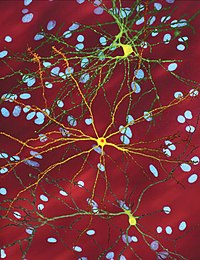
Photo from wikipedia
Fluoropyrimidines (FP) are mainly metabolised by dihydropyrimidine dehydrogenase (DPD), encoded by the DPYD gene. FP pharmacogenetics, including four DPYD polymorphisms (DPYD-PGx), is recommended to tailor the FP-based chemotherapy. These polymorphisms… Click to show full abstract
Fluoropyrimidines (FP) are mainly metabolised by dihydropyrimidine dehydrogenase (DPD), encoded by the DPYD gene. FP pharmacogenetics, including four DPYD polymorphisms (DPYD-PGx), is recommended to tailor the FP-based chemotherapy. These polymorphisms increase the risk of severe toxicity; thus, the DPYD-PGx should be performed prior to starting FP. Other factors influence FP safety, therefore phenotyping methods, such as the measurement of 5-fluorouracil (5-FU) clearance and DPD activity, could complement the DPYD-PGx. We describe a case series of patients in whom we performed DPYD-PGx (by real-time PCR), 5-FU clearance and a dihydrouracil/uracil ratio (as the phenotyping analysis) and a continuous clinical monitoring. Patients who had already experienced severe toxicity were then identified as carriers of DPYD variants. The plasmatic dihydrouracil/uracil ratio (by high-performance liquid chromatography (HPLC)) ranged between 1.77 and 7.38. 5-FU clearance (by ultra-HPLC with tandem mass spectrometry) was measured in 3/11 patients. In one of them, it reduced after the 5-FU dosage was halved; in the other case, it remained high despite a drastic dosage reduction. Moreover, we performed a systematic review on genotyping/phenotyping combinations used as predictive factors of FP safety. Measuring the plasmatic 5-FU clearance and/or dihydrouracil/uracil (UH2/U) ratio could improve the predictive potential of DPYD-PGx. The upfront DPYD-PGx combined with clinical monitoring and feasible phenotyping method is essential to optimising FP-based chemotherapy.
Journal Title: Journal of Personalized Medicine
Year Published: 2020
Link to full text (if available)
Share on Social Media: Sign Up to like & get
recommendations!